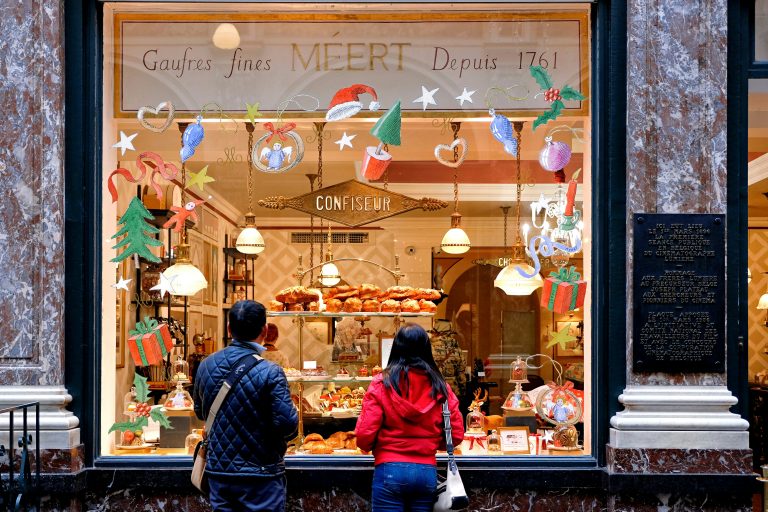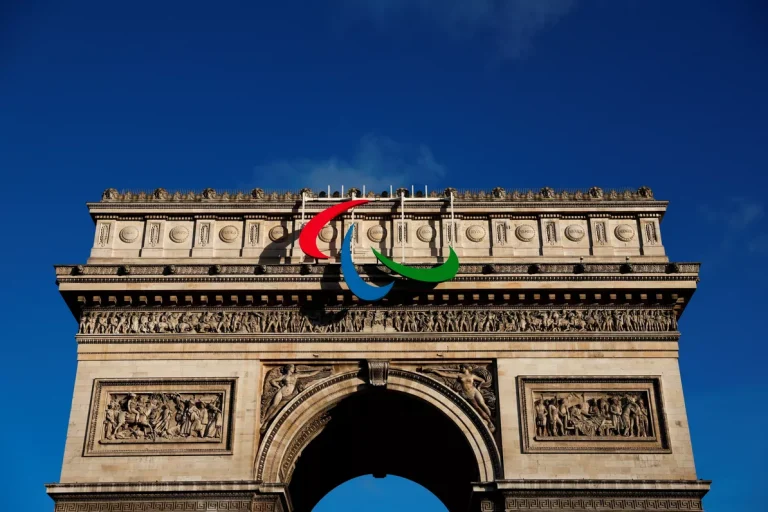Charlie Chaplin could well have filmed his masterpiece in Pantin: the town is replete with half-forgotten industrial sites, relics of its Golden Age during the second wave of industrial expansion in northeast Paris. Feel free to don a bowler hat, take to your bicycle and follow us as we get into full ‘Modern Times’ mode and explore the nooks and crannies of Pantin’s industrial heritage!

Starting point: Station n° 35008 Place de l’Église – Pantin
Finishing point: Station n°35014 Charles de Gaulle – Jean Lolive
Distance travelled: approx. 6 km
Journey time: approx. 1 hour 30 minutes. This urban itinerary includes carriageways shared with buses and taxis, try to avoid rush hour!
En route to the cité Théophile Leducq housing estate!

© Pavillons Leducq, Pantin, old postcards on Wikicommons
Take the cycle path (be aware that buses turn onto the street at this point) on Avenue Jean-Lolive. The entrance to the parc de la Manufacture des Tabacs park will be on your right after a few metres. This old cigarette factory was built in 1876 during the first wave of industrialization. It closed in 1982, was turned into office space and then a park, meaning that everyone gets to enjoy its grounds. Continue along Avenue Jean Lolive. Go down Rue Courtois (on your left) as far as the intersection with Rue du Dr Pellat and turn down this street as far as number 3 Rue du Dr Pellat.
This is the site of the town’s first public nursery. It was opened by the town council for the children of the cigarette factory workers. At the time, they worked from 5.30 in the morning until 8pm at night…it’s hard to imagine what their working day must have been like! Retrace your steps and turn left onto Rue Courtois. Take the first on the right down Rue Jean Nicot. Then take the first street on the left (Rue Théophile Leducq) and you’ll arrive at Cité Théophile Leducq.
Théophile Leducq ran a laundry business and was one of the biggest employers in Pantin. He built low-cost housing for his staff modelled on the ‘corons’[1] of northern France and English workers’ housing estates with their characteristic red brick construction. If you look carefully at the five buildings, they each have a different exterior design, making it possible to tell each apart.
Let’s leave the workers behind and add some grist to our mill as we head towards the Moulins de Pantin!
The ‘Grands moulins alsaciens’ flourmills in Pantin

©Le Canal de l’Ourq et les Moulins de Pantin, old postcards on Wikicommons
At the end of rue Théophile Leducq, turn right onto the cycle path on Rue Charles Auray, then turn left onto Avenue du 8 mai 1945, keeping to the cycle path. At the end of the avenue, turn right onto Rue Jules Auffret. At the crossroads, turn left onto the cycle path on Avenue Jean Lolive.
Next, turn right onto the cycle path on Rue Etienne Marcel. It leads to the banks of the canal. Turn left and pass underneath the Pont de la Mairie bridge. You’ll come to the tram bridge which has a separate pathway for cyclists and pedestrians. Cross over this bridge (the pont du canal de l’Ourcq). Stop in the middle to enjoy the view over the Grands Moulins de Pantin flourmills.
The banks of the canal were an ideal location for factories due to the possibilities they offered in terms of transporting goods via the waterway, their close proximity to Paris and the railways and roads running alongside the canal. Taken together, these multiple transportation links enabled the development of an important logistical hub.
Look at how tall the buildings are! They housed enormous machinery modelled on traditional mills in Alsace and at their height produced up to 190,000 tonnes of flour each year. After being bombarded during WW2, the buildings were partly rebuilt by architect Léon Bailly and converted in a semolina processing plant. A permanent end to milling activities happened at the beginning of the 21st century. The site was sold, then converted into office space for a large bank, which is there to this day. The whole district was redesigned in a way that recalled former times, with multiple services catering to workers such as cafés, a health centre, multimedia library, gym, terraces and gardens…everything to make life a little easier!
Keep straight after the bridge and go around the Grands Moulins via the rue du Débarcadère. Take the first right until you’re beside numbers 6, 7 and 9, Rue du Général Compans. It’s time to head to the laundry.
The Elis laundry and workers’ housing

©Le Canal de l’Ourq et les Moulin, Patrick Charpiat, Wikicommons
You’re now in the heart of the laundry district. Although care of clothes and linen (laundering, bleaching, ironing) was one of the oldest industrial activities in the Paris area, the insanitary conditions prevalent in Paris forced these trades to set up shop on the outskirts at Boulogne or along the Bièvre river for example. Théophile Leducq chose the town of Pantin because the water in the shallow phreatic zone here was both warm and soft (i.e. lower in certain minerals than hard water). Here he also found all the raw materials crucial for his business thanks to neighbouring soap-making concerns, makers of washing powders and bleaches.
Théophile Leducq initially expanded his business by investing in a new, massively scaled-up approach to laundering using steam and a spin-drying method. Alongside this he offered novel business services such as linen hire for large businesses (hotels, butchers, hairdressers and restaurants), followed later on by a system of charging for laundry by weight, started by his son. The firm’s expansion was only halted with the more widespread adoption of washing machines by individual households.
Look at the buildings at numbers 6, 7 and 9 on Rue du Général Compans. The initials of Théophile Leducq’s son Maurice are carved above n°7. He had these apartments built for the workers: the section built from gritstone housed the laundry and the brick-built sections contained the workers’ flats.
Let’s leave laundry baskets behind to explore another famous spot in Pantin, also connected with water.
From perfumes to chlorinated water

©Piscine de Pantin, Parisette, Wikicommons
Turn down Mail de la Blanchisserie (beside the restaurant, where Rue du Général Compans turns into Rue Danton). Go down this street until you reach Avenue Edouard Vaillant. Cross over the avenue (if possible, on foot at the traffic lights) to reach Avenue de la Gare. Pass in front of the station, then turn right (Rue Sadi Carnot) with the Parc Salvador Allende on your right. Pay attention as you cross the street at the bottom (Avenue du Général Leclerc) and turn left along the cycle path. Stop in front of 49 Avenue du Général Leclerc.
Look at these two typical 1930s buildings: one is the old water treatment plant, the other Pantin’s municipal swimming pool. Both were designed by the same architect and engineer team, newly-qualified architect Charles Auray, (son of the mayor of Pantin at the time) and experienced water engineer Jean Molinié. The swimming pool was a novelty at the time, as France had very few such pools in the interwar period, in contrast to the United Kingdom, for example. Paris and its suburbs were amongst the first to construct these facilities. The location, near to the water treatment plant was ideal for a swimming pool, delivering as it did water at a comfortable 26°C. The treatment plant was opened in 1935 and the swimming pool in 1937.
Let’s move onto rather more pleasant smells.
Keep heading down Avenue du Général Leclerc until you’re almost at the railway overpass. Turn right onto the cycle path and go up Rue Delizy. The building on your left on the corner of the street sporting a large clock on its facade is the former Bourjois perfume factory.
This is the last survivor of the perfume industry, which once had a significant presence in Pantin. In 1889, the Paris-based company Bourjois bought the Wertheimer site, which was already being used in the production of perfume and soap. In 1891, the site expanded, going from a small-scale production model to become a centre for the mass production of various beauty and care products like perfumes, soaps and creams. In 1928, Ernest Beaux created the perfume « Soir de Paris », which was a global hit. Perfume was beginning its journey from luxury product to everyday item.
The production of perfumes ceased in 2007 but Chanel has since moved its research and development facility here and the magic goes on…
The Magasins Généraux de Pantin

©Magasins Généraux, Hervé Abbadie, Wikicommons
Continue down Rue Délizy and cross the Pont Delizy bridge. Next turn down Rue Victor Hugo at the traffic lights and continue until you reach number 39. Cross the square carefully (bicycles are permitted as long as they’re being ridden slowly) in front of the old Louis factory – on the other side you’ll find the canal! Turn right and follow the canal side until you reach Place de la Pointe and the ‘Magasins Généraux’ (now known as Dock B).
Opened in 1822, the canal de l’Ourcq swiftly became a strategic location for various industrial concerns. In 1899, Paris Chamber of Commerce planned « warehouses suitable for all types of goods. The geographical location is suitable for boats and wagons and there is no need for any bureaucratic formalities. Shipments can be moved in and out of Paris without the city running the risk of losing out to fraud. We might call it a large logistics hub« .
The Magasins Généraux looked something like ships stranded on dry land. They stored grain and flour, transported via the canal. Later on, they became a giant playground for graffiti artists before being converted into offices for a large PR company.
To return to almost where you began, cycle down the Passage de la Dune, towards Avenue Jean Olive, being careful to treat pedestrians with respect. You’ll find yourself in front of the Parc de la Manufacture des Tabacs! You’ve nearly come full circle. Turn right along Avenue Jean Lolive until you get to the Charles de Gaulle – Jean Lolive Vélib’ station (there’s no need to cross the avenue to your actual starting point).
[1] ‘Miners’ cottages in the north of France.’ Dictionnaire Larousse.


